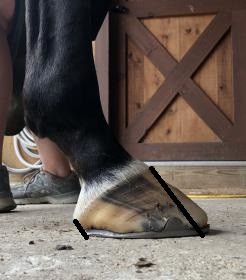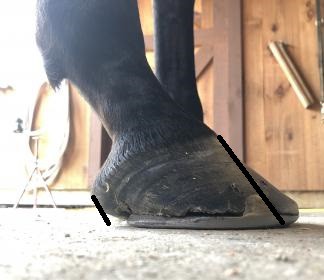Oh just to clarify, the pics I just posted are 5 weeks after the shoeing job pictured in post #4. I thought people might be interested (and maybe a little horrified?) to see the progression.
Same thing happened to me. At the time, trainer switched farriers from a well-known CJF to a different CJF who came highly recommended by the well-known farrier (who had gotten too busy for us). New farrier left me with feet that looked almost identical to your guy’s and a seriously lame and body sore horse. AFAIK, trainer still uses that farrier. Absolutely insane to me. Is it a knowledge gap and/or unwillingness to ask for help on the part of the farrier? I didn’t stick around long enough to ask. 
I have known at least one farrier who gave very different efforts to different horses/owners. The owners of the higher level horses loved him, he did an excellent job with their horses. The rest – I dunno what he was thinking, or why – slipper toes and no heels. One horse needed wedges to help get his feet back into shape (by a different farrier). His charges were at the same rate for everyone.
Don’t know if that is the case with Farrier B … it might be interesting to see your friend’s horse’s feet.
Wow, that is really shitty! It’s one thing to think you’re doing things correctly but be wrong, and another to give clients different levels of service. I wonder if he was conscious of it at all, or just lazy, or what? I can’t imagine giving less than my best effort to all clients.
I did look at her horses’ feet before I started using the farrier and they looked fine to me when freshly done, but he did mention on his second visit to me that he shoes dressage horses (like hers) differently than eventers/jumpers (like mine, although I do dressage too). Also one of hers is barefoot and another he was just doing for the first time when I saw him. I’d be curious to see them again after a few months. It’s also possible that I misjudged things because I sometimes find hooves easier to evaluate in photos than in person, unless they’re extremely bad—something for me to work on!
She did ask me a couple months ago if I was pleased with his work so maybe she’ll ask again and I can be tactfully honest. I’d hate to see her horses suffer.
It’s possible that different disciplines need slightly different shoeing setups, so that on its own isn’t out of the realm of possibility. There’s just a (potentially big) difference between how Dressage horses are asked to carry themselves, vs Hunters/Jumpers/Eventers, depending on the level of performance. But it sounds like he’s using that as an excuse
Also one of hers is barefoot and another he was just doing for the first time when I saw him. I’d be curious to see them again after a few months. It’s also possible that I misjudged things because I sometimes find hooves easier to evaluate in photos than in person, unless they’re extremely bad—something for me to work on!
Unless you’re getting on the ground and looking from that view - same as taking pictures - it can be easy to miss things that are/are starting to go badly. Bare feet have a much better chance at overcoming some shortfalls in trimming if they’re getting enough movement on abrasive enough footing.
Some farriers are only good at managing feet that are already well-balanced, have good quality material, but even them, it’s not hard for those feet to slowly, very slowly, devolve over several years, until “suddenly” the horse is lame. But give them feet that are weaker quality (genetics, diet, movement, whatever), or that are already not trimmed well, and they can’t fix things, and their lack of education (or care) allows things to get worse over time, just more quickly since the feet were compromised to begin with.
:no: oh my… so sorry about this.
so sorry about this.
eta: I see that you said these are 5 weeks out… they should not look like this after 5 weeks… Heels are totally collapsed with shoes set to the toe that are way too long. Jingles that you can find someone better.
Yep I know. Horse has always been on a 5-week cycle and has never looked like this at the end before. Amazing what two cycles of subpar farrier work can do.  I’m so sorry that I put the poor guy through this.
I’m so sorry that I put the poor guy through this.
Just to give you a visual just how much these feet need to come back
[ATTACH=JSON]{“data-align”:“none”,“data-size”:“full”,“title”:“image_67671.jpg”,“data-attachmentid”:10744709}[/ATTACH]


Oh, rats. Not the kind of update one hopes for! @Libby2563 my PMs are weirdly not showing up or notifying all the time - I think we chatted briefly? but I can’t find 'em! Did you end up having luck contacting anyone else for help or assessment? That RH in particular I am very concerned about!
Yikes! I would NOT be using Farrier B again. I see where the hooves need to be but I wonder how much sole depth the horse has to work with. I don’t think there will be a fast fix for these feet but no need to go backwards.
I did know a very good farrier who used to do several friends horses. He was getting older so decided to go for quality instead of quantity. So he would only do a certain number of horses a day and charged 4 to 5 times as much as other farriers. These friends’ horses’ feet always looked fabulous. But they had great feet anyway. Then an acquaintance convinced him to do her young horse that was having multiple feet problems ( quarter cracks, etc.). When he did her horse it had duck feet!!! She was not happy but then she was a nut case who had run thru 6-8 farriers in an 8 week period. I don’t know if he couldn’t shoe a horse like hers or just didn’t want to deal with her again. It was strange.
I am sure that is not your case! I still wonder how back feet can look like that. How do their angles get like that??? Not condemning - just curious. I guess because I have had some farriers I had to fire but the back feet never were a problem. Maybe because they were barefoot behind?
Sole depth, my guess would be paper thin ;(
There are a lot of farriers out there who do fine with horses that don’t tend to grow like this if left too long, and very few who seem to know how to correct them when they get this way.
Honestly even the seller’s farrier didn’t have this horse’s feet in good shape. All 4 were, and remain, underrun with crushed heels. Farrier A actually allowed a negative palmar angle to develop in addition to the heels running off. The wedges helped realign the foot, but without an effort made to reduce toe depth, the issue won’t resolve. You need to find a farrier who is versed in rehabbing feet like this horse has.
The toe LENGTH needs to come back… I can guarantee you cannot take anything from the bottom of this foot at the toe. His soles are probably pretty darn thin. The negative angle is being caused by the very long toe and heel’s that are folded under and crushed.
I don’t use vet/podiatrist/farriers combo groups anymore. I got burned really bad - $700 shoe job that had to be taken off less than 24 hours later due to a severely bleeding quarter crack. Your podiatrist sounds flaky and cocky and arrogant, and I’m not into that at all. I wouldn’t waste another red cent on that person.
Good luck, and keep your eyes peeled for horses with nice feet - never be too shy to ask who they use.
Yes! And this is why so many farriers get into trouble - they are only thinking of vertical toe height and “I can’t take more toe without making him sore” - of course you can’t.
They can’t see there’s way too much horizontal toe length. Toe length is not the same as toe wall height.
I am going to refer to it as HORIZONTAL toe length from now on… that way there is no confusion.
Yes, vertical height vs horizontal length really seems to paint a much more clear picture for almost everyone 
Just to complicate it even further, for fun - hind toes in particular often get “long” by getting tall - but not necessarily by growing excessive toe wall height. When you have significant NPA in the hinds, often you do end up needing to lower the plane of the toe behind the white line to correct the way that excessive toe manifests in hind feet. This is because of the mechanics of how long hind feet are generally loaded: camped under with overly weighted heels. You’ll often see very fat frogs on these hinds, which can be tempting to see as “oooh, nice healthy frog!” but it’s truly because they are oversharing their burden of load. This is part of the challenge of really rehabbing NPA in hinds - often, even if we are diligent in bringing the toe wall back to the white line and putting an aggressive bevel on it we don’t see significant progress because of how the foot has distorted forward.
Lowering the toe plane to correct this kind of distortion can leave them a tender if they are bare, as you have to rasp into calloused sole at the toe - generally such a massive no-no! But it’s something to be done thoughtfully and conservatively over several trims - even if you are adding an appliance to help with comfort. It’s NOT simply hacking away at the hoof behind the WL, but deliberately removing only enough material to help recalibrate the balance of the foot.
It’s definitely something that needs to be approached with caution as to not cause injury. Measuring the collateral grooves can give you a good idea of sole depth but it would probably be best to have rads to be sure.
I have one who can go negative behind really quick, but he doesn’t have the depth at the toe to attempt to raise the angle by taking from the toe. Right now I have him at probably 0 and that’s a big improvement from where he was. He has come up 2 degrees. It’s a challenge to get him to build more heel behind, but not a problem up front.
This is definitely one that I would want to pull the shoes and use boots and pads to engage the back of the foot. That along with proper frequent trims would start to turn this foot around pretty quick I suspect.
